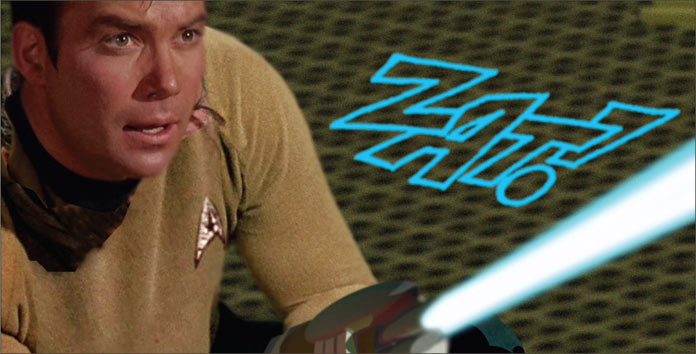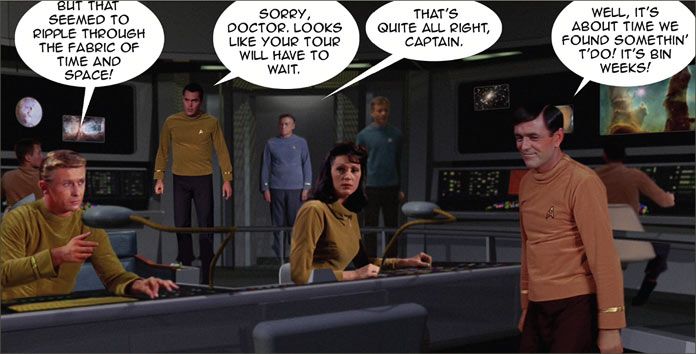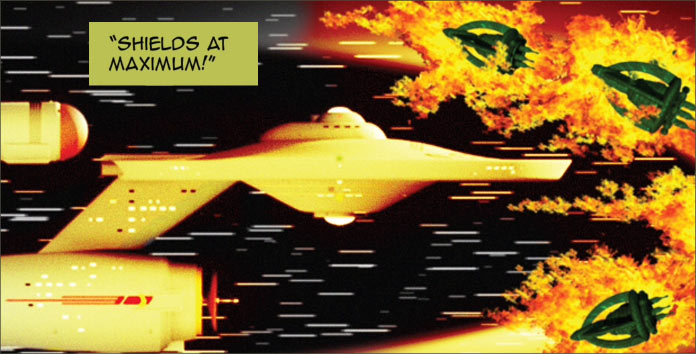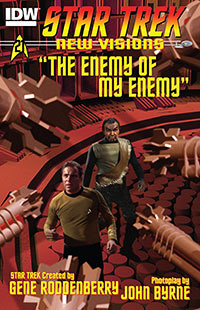I’ve always felt that the original Star Trek is timeless, that it works in any decade.
Though the classic series is clearly a product of the 1960’s, it’s still a show that manages to capture the minds and hearts of generations of fans — but there are still some elements of 60’s camp in there.
It takes a talented storyteller to understate these elements and focus on the ones that emphasize the fun of Star Trek.
John Byrne’s Star Trek: New Visions #21 isn’t simply about nostalgically re-living the glory days of the original series, despite what a lot of my fellow classic Trek fans may think. Though that is a clear and obvious draw to the book, and I am guilty of falling under that spell, it’s about keeping to the original spirit of TOS by recognizing its timeless nature, but through the magic of image manipulation, Byrne manages to give TOS a slight edge that makes it seamlessly fit into a 21st century perspective — and that’s something that he manages to do in a masterful but subtle way.
Before we take a look at some of these methods, let’s look at the stories first. The first sees Klingon commander Kor and Captain Kirk, taken prisoner by a race known only as the Vrotii. They have a reptilian appearance to them but try to imagine them with the physiques of Gorn bodybuilders who have let themselves go and now just eat a lot. An original creation of Byrne, they’re not a graceful race but their size and martial attitude are both very intimidating.

Kor and Kirk are forced to work together to escape their captors, with the crew of the Enterprise searching for their captain. I don’t want to give too much of the story away, but there’s a dynamic at play in this story that’s very reminiscent of a film that would have been well-known to a 1960’s audience. Yet, with this film not likely familiar to a modern audience, Byrne makes what’s old, new again.
But even the title: “The Enemy of My Enemy,” is a clear reference to the old Arabic axiom “the enemy of my enemy is my friend.” That’s completely something that James Kirk, known to his fans as a student of history, would say, and in fact, he did — but not in a TOS episode, in a line from 2013’s Star Trek: Into Darkness. While it’s not Shatner’s Kirk but Chris Pine’s line, it is a 21st century resonance used in a representation of the 1960’s series and one that is a subtle way of bridging the gap between the two productions.
But speaking of subtlety, if you look at Kor’s forehead, notice the slight ridges present? Though it’s still John Colicos’s Kor, decked out in his fringed sash and shiny sleeveless top, Byrne has taken some liberties with his forehead. It’s a brilliant little difference that original TOS fans, like me, would notice but willingly accept as it fits into existing canon and supports, rather than supplants, the franchise.

The second story, “The Rhyme of the Ancient Mariner,” is a reference to a classic epic and supernatural English poem about a cursed sailor by Samuel Taylor Coleridge, published in 1798. It’s a classic English Literature piece of poetry and one that everyone should know, particularly given Star Trek’s connection to naval tradition.
But what I like is that Byrne weaves another piece of classic English fiction into this story, namely “The First Men in the Moon” by H.G. Wells.
The Enterprise encounters a mysterious space ship, unpowered and adrift in space. Its configuration is unknown yet its metallic signature indicates its origin is of the early 20th century – which would put it about the same time as H.G. Wells’ novel. When a lone occupant is discovered, whose name is of one of the characters from the novel, the crew of the Enterprise has a mystery afoot.
This story is set in the time when the Enterprise was captained by Christopher Pike – but close to the era of “Where No Man Has Gone Before,” as Pike and Number One are joined by Chief Engineer Scott and Dr. Mark Piper. It’s a retro-look of a retro-look, but what I find interesting is the similarities of the Star Trek pilot images (which Byrne clearly leaned heavily on) to the current series, Star Trek: Discovery. The away team jackets do bear somewhat of a similarity to the current uniforms, though somewhat modernized.
I was surprised that I hadn’t noticed that before, but again, that’s one of the understated ways that Byrne’s work manages to make itself adaptable to a modern point of view. Though Byrne isn’t responsible for the look of the Discovery uniforms, he does remind us of the inspiration.

I have to say, it was highly enjoyable seeing Jeffrey Hunter’s image in the role of Captain Pike as well as that of Majel Barrett playing Number One. But that’s the joy of this series. If fans of today’s age didn’t know who these actors were, imagine their excitement when they finally realize their identities? That’s a pleasure that Byrne manages to give these 21st century Star Trek fans with this book.
Getting back to “The Enemy of My Enemy,” the ending of this story was also a hallmark reminder of the fact that eventually the Klingons do become allies with the Federation. Given that Discovery is set during the time when the Klingons and Federation began their war, this story punctuates with its ending. Hardly a spoiler as we know what eventually happens, but Byrne uses this story as the marker point in history when the war between the Klingons and the Federation ended. Again, he takes the opportunity to subtly ease the time of the TOS adventures into the existing framework.
I think the reason why Star Trek fans are so fixated on canon is because it gives them a sense of security. Star Trek has an appeal based on the fact that it offers a future where society works. It’s virtually Utopian in a way because money isn’t an issue, people are free to pursue meaning in their lives without threat to their way of living and all of this is possible because of the storyline that was set out by Gene Roddenberry.

When things change – because writers want to make changes for whatever reason is important to them, – fans react in a very dramatic fashion. Their fantasy universe is threatened by these changes and that’s why adverse reactions are expressed. Tell me: what other franchise had established canonical resources like the Starfleet Technical Manual or the Star Trek Concordance prior to 1977?
Star Trek fans have deep-seated connections to this imaginary universe and I think John Byrne is very sensitive to that and it is reflected in the respectful amount of detail he puts into portraying these stories.
Byrne keeps the fun in Star Trek. I like to consider myself somewhat of a canonically-attentive person, as are a lot of Trek fans, but I also want to enjoy Roddenberry’s universe. Is the story good and does it match up with the expectations he set out? If so, then, I want to have fun. Byrne does that for me and a lot of other readers. He is not only a comic creator, but a Star Trek fan and one that I could probably have a good conversation with him about what we both loved in the original series.
Byrne focuses on those elements of fun. He is detail-oriented, but he knows how to craft a story and use those elements to the story’s advantage — and I’ll be sad to see this series conclude when Byrne wraps up Star Trek: New Visions this year.

